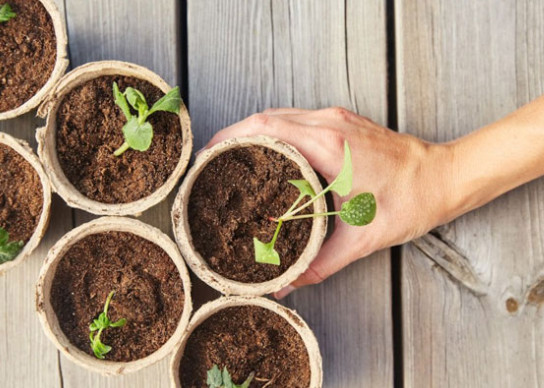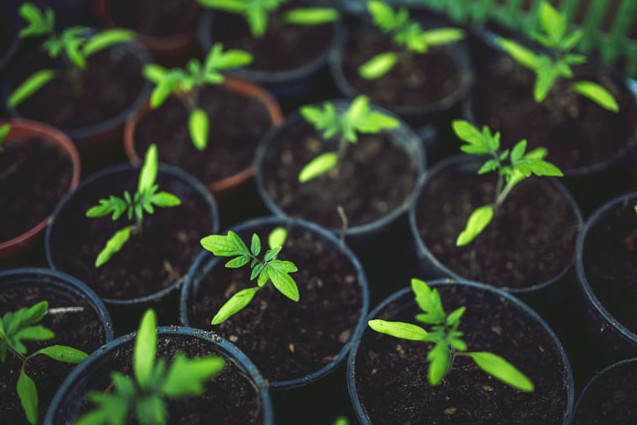A guide to making good soil for houseplants of all kinds
Have you ever noticed how beautiful and fresh some people’s vases look? The only difference is that they take better care of their pots and are aware of the factors that contribute to flower growth and flowering. Potting soil is one of these factors. As a result, we have explained the types of potting soil, the best soil for each pot, and other tips in this article.

Identify the types of potting soil:
- Soil that is sandy;
- Silt or clay;
- The clay
Next, we will discuss soil types and their characteristics. Here is an important point to keep in mind before introducing soil types:
Sand, silt, and loam make up soil. Each of these factors affects the soil texture, which in turn affects drainage capacity and nutrient availability.
- Soil that is sandy
The bulk of the soil is sand, which is devoid of nutrients. Sand is easier to work with than clay. This soil drains quickly and retains nutrients poorly. Sand-loving plants include:
This flower grows in soils with a pH close to neutral and is drought-resistant.
Common wormwood: This plant is perennial, meaning it lives for more than two years. In sandy soils that are not very fertile, common wormwood grows well.
- Silt or clay
Silt soil is fertile and powdery. The possibility of a land being saturated with water is high if a large part of its soil is of this type. Clay soil is suitable for the following plants:
Plants like yellow iris adapt to the environment and grow in places like garden ponds or streams.
It grows well around ponds and moist environments since it loves water.
- The clay
The components of clay stick together to form larger lumps. While this soil is very fertile, it becomes heavy and does not drain well when it contains a large amount of clay. There are plants that grow well in such soil, of course

How do I choose the best soil for pots?
Clay, sand, and clay are the best soils for pots. Loam is a composition like this. All the main types of potting soil can be found in loam.
Sand, silt, and clay are the three main types of soil in loam soil. Why is this soil suitable for planting flowers and plants?
Ideally, soil should have a pH value between 6 and 7. Plant growth is affected by soil pH. Plants, organisms, and other beneficial soil compounds such as beneficial worms thrive in this range of acidity.
Calcium is essential for plant growth. Potting soil contains chemicals that are balanced by calcium. Calcium also improves the soil’s ability to hold water. Calcium-rich soil allows water and oxygen to reach the roots and reduces salt levels in potting soil. Salt destroys roots and prevents the plant from absorbing nutrients, preventing it from growing properly.
Most of the time, you need to add compost to the soil of pots to improve their condition. Depending on the density of the soil, sand and peat are added to each pot. It is important to remember that the best soil for a pot depends on its type and growing conditions. It may be necessary to apply household or industrial fertilizer to the plant at times.
Are there any other suitable materials for potting soil?
It is important to know other materials as well as soil composition when choosing pots for your plants. Here are the materials we mentioned.
Decomposed plants in swamps produce peat, which is a type of organic mineral material. The soil composition of most pots contains peat, which retains moisture without getting wet and saturating the soil. The material is light and does not easily compress.
2 – Compost strengthens the soil of the pots and reduces air spaces in the soil. Pots should not be made from this material. Compost should make up only one third of the soil in the pot.
- Tree trunk bark
For pots, ground and partially composted tree bark is also used instead of peat moss. The mixture is cheaper than peat and helps the soil breathe. It dries out faster than peat and requires more watering.
- Fiber from coconuts
Coconut fiber is a fibrous material derived from coconut shells. Peat is sometimes substituted with coconut fibers. Peat fibers have the ability to retain water without wetting the soil, which makes them similar to these fibers.
- The mineral vermiculite
Mica stone chips are also heated to produce vermiculite. Gray in color and spongy in texture, it retains water in the soil of the pots. Nutrients are held in vermiculite for a longer period of time and are more readily available to plant roots.
What should the pot soil look like?
A garden’s best soil depends on the type of flower bulb, the seed and the planting environment. A loamy or sandy soil is ideal for growing onions and most flowers.
Loam and sand combine to provide excellent drainage and prevent flower seeds from rotting. Plant roots grow easily in such soils.
Plant flowers and plants in pots or flower planting boxes when the soil texture is the best.
Compost, peat, and topsoil are the best soils to use when preparing a garden for flowers. Combining these three should result in an equal ratio.
How do I choose the best soil for planting vegetables?
Planting vegetables in the best soil depends on the type of garden you have. The use of compost and mulch will be beneficial if your garden has a prominent bed and the roots are planted more than one meter from the ground. There should be an equal ratio between these two.
It is important to choose soil that drains well if you plan to grow vegetables in the field. For good drainage, clay soil needs some amendments.
How to make soil for an apartment pot:
- The soil in the garden should be sterilized
You must sterilize garden soil before using it in indoor pots. As a result, insects, weeds, and diseases are eliminated from the soil. Bake the garden soil for 30 minutes at 180 degrees on the baking paper. A little smell is created by this useful action that destroys bacteria, but it is worth it.
Mix the soil with sandy soil and peat after this step. Soil will be moist, oxygenated, and properly drained as a result.
- You can make the soil composition yourself
The right combination can be made by you. Using this method, you can determine the soil’s quality. Below is the tutorial for making potting soil:
Peat moss soil in the amount of 380 liters;
Perlite soil in the amount of 380 liters;
Bone powder weighing 4.5 kg;
Blood powder weighing 2.25 kg;
Limestone weighing 2.25 kg.
Put all the ingredients in an airtight container or pot and mix well.
